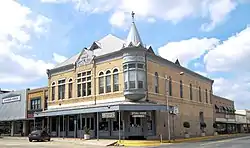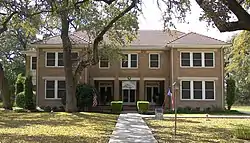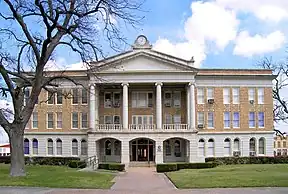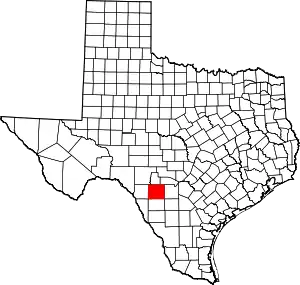Uvalde, Texas
Uvalde is a city and the county seat of Uvalde County, Texas, United States.[6] The population was 15,217 at the 2020 census.[3] Uvalde is located in the Texas Hill Country, 80 miles (130 km) west of downtown San Antonio and 54 miles (87 km) east of the Mexico–United States border.[7]
Uvalde | |
|---|---|
City | |
Uvalde City Hall Fountain on the Leona River in Uvalde Memorial Park Uvalde County Courthouse | |
.png.webp) Seal | |
| Nickname: City of Trees | |
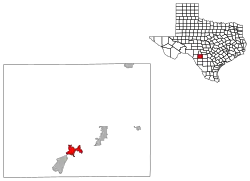 | |
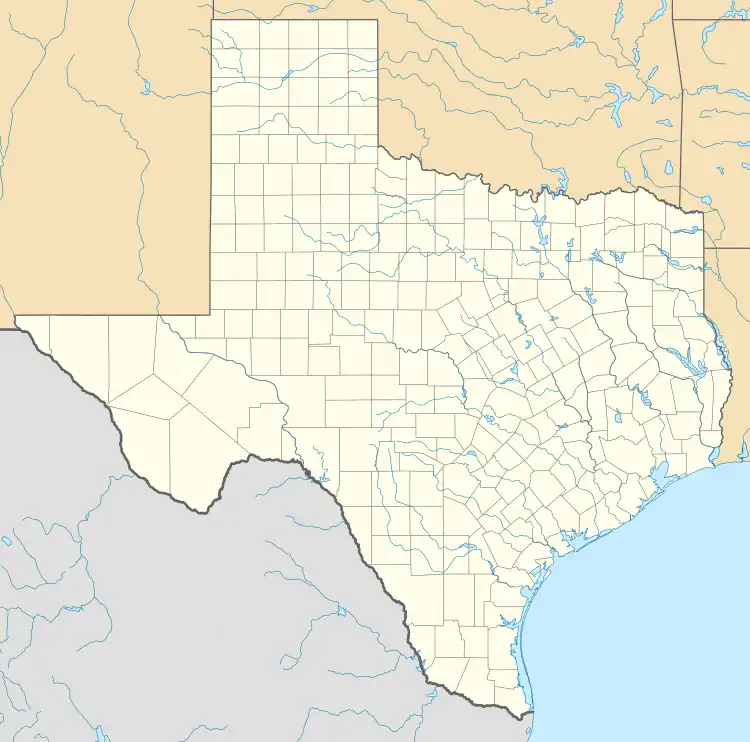 Uvalde Location in Texas  Uvalde Uvalde (the United States) | |
| Coordinates: 29.21°N 99.79°W | |
| Country | United States |
| State | Texas |
| County | Uvalde |
| Named for | Juan de Ugalde |
| Government | |
| • Type | Mayor–council |
| • Mayor | Don McLaughlin (R) |
| • City Manager | Vincent DiPiazza |
| Area | |
| • Total | 7.67 sq mi (19.87 km2) |
| • Land | 7.66 sq mi (19.85 km2) |
| • Water | 0.01 sq mi (0.02 km2) |
| Elevation | 909 ft (277 m) |
| Population | |
| • Total | 15,217 |
| • Estimate (2021)[4] | 15,312 |
| • Density | 1,983.96/sq mi (766.6/km2) |
| Time zone | UTC−6 (CST) |
| • Summer (DST) | UTC−5 (CDT) |
| ZIP Codes | 78801–78802 |
| Area code | 830 |
| FIPS code | 48-74588[5] |
| GNIS feature ID | 1370541[2] |
| Website | uvaldetx.gov |
Name
Uvalde was founded in 1853 as the town of Encina, but was renamed in 1856 as Uvalde. Its name is a misspelling of the Spanish governor Juan de Ugalde (Cádiz, Andalusia, 1729–1816). Ugalde is a name of Basque origin, meaning water-side or river.[8]
Pronunciations of the name of the town vary. One common pronunciation is the fully Anglicized version (/juːˈvældi/ ⓘ yoo-VAL-dee). A fully Spanish version is also in common use, which is often approximated by English speakers as /uːˈvɑːldɛ/ oo-VAHL-deh. There are also pronunciations that combine the English and Spanish versions. The chosen pronunciation often shows how strong a person's connection with the Hispanic community is or general knowledge of its pronunciation.[9]
History
Uvalde was founded by Reading Wood Black in 1853 as the town of Encina. In 1856, when the county was organized, the town was renamed Uvalde after Spanish governor Juan de Ugalde (Cádiz, Andalusia, 1729–1816) and was chosen as county seat.[9] It is the southern limit of the Texas Hill Country and is part of South Texas. Uvalde is known for its production, dating back to the 1870s, of huajillo honey (also spelled guajillo), a mild, light-colored honey.[10][11]
Robb Elementary Massacre
On May 24, 2022, 19 children and two adults died, and 18 others were injured, in the Robb Elementary School shooting. Videos show police officers waiting for over one hour before entering a classroom to stop the shooting. Footage shows officers standing on the other side of the wall not responding to the shots being fired which resulted in 21 deaths.[12][13]
Geography
Uvalde is located at the crossroads of U.S. Hwy 90 and U.S. Hwy 83.[14]
According to the United States Census Bureau, the city has a total area of 7.6 square miles (19.8 km2), all of it land.[15]
Climate
The climate in this region is characterized by hot, humid summers and mild, dry winters. According to the Köppen climate classification system, Uvalde has a humid subtropical climate, Cfa (inclining toward Cwa), on climate maps.[16]
Demographics
| Census | Pop. | Note | %± |
|---|---|---|---|
| 1880 | 794 | — | |
| 1890 | 1,265 | 59.3% | |
| 1900 | 1,889 | 49.3% | |
| 1910 | 3,998 | 111.6% | |
| 1920 | 3,885 | −2.8% | |
| 1930 | 5,286 | 36.1% | |
| 1940 | 6,679 | 26.4% | |
| 1950 | 8,674 | 29.9% | |
| 1960 | 10,293 | 18.7% | |
| 1970 | 10,764 | 4.6% | |
| 1980 | 14,178 | 31.7% | |
| 1990 | 14,729 | 3.9% | |
| 2000 | 14,929 | 1.4% | |
| 2010 | 15,751 | 5.5% | |
| 2020 | 15,217 | −3.4% | |
| 2021 (est.) | 15,312 | [4] | 0.6% |
| U.S. Decennial Census[17] Texas Almanac: 1850–2000[18][19] 2020 Census[3] | |||
2020 census
As of the 2020 United States census, there were 15,217 people, 5,217 households, and 3,663 families residing in the city.
| Race | Number | Percentage |
|---|---|---|
| Hispanic or Latino (of any race)[lower-alpha 1] | 11,939 | 78.46% |
| White (non-Hispanic) | 2,917 | 19.17% |
| Multiracial | 128 | 0.84% |
| Asian | 125 | 0.82% |
| Black or African American | 50 | 0.33% |
| Some other race | 39 | 0.26% |
| Native American or Alaska Native | 16 | 0.11% |
| Pacific Islander | 3 | 0.02% |
| Total | 15,217 | 100% |
2010 census
At the 2010 census,[5] the population was 15,751.
2000 census
As of the census of 2000, 14,929 people, 4,796 households and 3,716 families resided in the city. The population density was 2,220.2 inhabitants per square mile (857.2/km2). The 5,313 housing units averaged 790.1 per square mile (305.3/km2). The racial makeup of the city was 78.3% Hispanic or Latino, 19.2% White, 0.47% African American, 0.62% Native American, 0.48% Asian, 0.07% Pacific Islander, 0% from other races, and 2.97% from two or more races.
Of the 4,796 households, 41.8% had children under the age of 18 living with them, 55.6% were married couples living together, 16.9% had a female householder with no husband present, and 22.5% were not families; 20.1% of all households were made up of individuals, and 10.4% had someone living alone who was 65 years of age or older. The average household size was 3.02 and the average family size was 3.50.
About 32.4% of the population was under the age of 18, 9.6% from 18 to 24, 25.7% from 25 to 44, 18.3% from 45 to 64, and 14.0% was 65 years of age or older. The median age was 31 years. For every 100 females, there were 90.3 males. For every 100 females age 18 and over, there were 85.5 males.
The household median income was $25,259 and for a family was $27,897. Males had a median income of $25,600 compared with $15,674 for females. The per capita income for the city was $11,735. About 24.2% of families and 29.0% of the population were below the poverty line, including 40.1% of those under age 18 and 23.8% of those age 65 or over.
Education
Uvalde is within the Uvalde Consolidated Independent School District, which operates Uvalde High School. Southwest Texas Junior College has a campus next to Uvalde on the site of Garner Field.[23] The Garner Field facility also houses a campus of Sul Ross State University.[24]
Arts and culture
The John Nance Garner House in Uvalde, which was home to John Nance Garner for 30 years, chronicles his life. Garner served as Speaker of the United States House of Representatives from 1931 to 1933, and as Franklin D. Roosevelt's Vice President from 1933 to 1941.[25] Also in Uvalde are:[26]
- The Aviation Museum at Garner Field has displays of World War II aircraft.
- The Briscoe Art and Antique Collection displays the collection of former Texas governor Dolph Briscoe.
- The Janey Slaughter Briscoe Grand Opera House hosts community theater and concerts.
Parks and recreation
Uvalde is known as one of the best locations for gliding in the United States. It was the site of the 1991 and 2012 World Gliding Championships.[27] The Uvalde area of the Texas Hill Country is home to many native and exotic species of animals, which allow sportsmen almost year-round hunting opportunities.[28]
Outdoor Life magazine named Uvalde County one of the best white-tailed deer hunting areas in the world.[29]
Notable people
- Oscar Albarado, world champion boxer
- Bobby Bonner, former MLB shortstop
- Dolph Briscoe, former governor of Texas
- Pete Conrad, former astronaut, resident for 30 years
- Dale Evans, actress
- King Fisher, gunslinger, sheriff of Uvalde County 1881 and 1883, buried in Uvalde
- John Nance Garner, the 32nd Vice President of the United States
- Pat Garrett, Old West lawman, killer of Billy the Kid, one time resident of Uvalde
- Carlos Guevara, former MLB pitcher
- Harvey Hildebran, former Texas state representative
- Dave Hilton, former MLB third baseman
- Ben Kinchlow, former co-host of The 700 Club
- Matthew McConaughey, Oscar-winning actor
- Vann McElroy, former NFL star and Super Bowl winner
- Tom O'Folliard, American outlaw, friend of Billy the Kid
- Brooks Raley, MLB pitcher for the New York Mets
- Marshall Ashmun Upson, American journalist, ghostwriter of Pat Garrett's 1882 book The Authentic Life of Billy, the Kid, buried in Uvalde
See also
Notes
References
- "2019 U.S. Gazetteer Files". United States Census Bureau. Archived from the original on October 17, 2020. Retrieved August 7, 2020.
- U.S. Geological Survey Geographic Names Information System: Uvalde, Texas
- "Explore Census Data". United States Census Bureau. Retrieved July 5, 2022.
- "City and Town Population Totals: 2020-2021". United States Census Bureau. July 5, 2022. Retrieved July 5, 2022.
- "U.S. Census website". United States Census Bureau. Archived from the original on December 27, 1996. Retrieved January 31, 2008.
- "Find a County". National Association of Counties. Archived from the original on May 9, 2015. Retrieved June 7, 2011.
- Google Maps Archived July 24, 2018, at the Wayback Machine (using "measure distance" tool)
- "Ugalde" (in Spanish). Bisabuelos. 2001.
- Sarmiento, Isabella Gomez (June 3, 2022). "How we pronounce Uvalde says a lot about the power of language in mixed communities". NPR News. Retrieved June 4, 2022.
- "Facts about Uvalde, site of latest Texas school shooting". The Dallas Morning News. May 24, 2022. Archived from the original on May 24, 2022. Retrieved May 24, 2022.
- "Nancy Beck Young, "San Antonio, Uvalde and Gulf Railroad Company"". Texas State Historical Association on-line. Archived from the original on June 21, 2013. Retrieved April 28, 2013.
- Casas, Angelica (May 25, 2022). "Texas shooting: 19 children among dead in primary school attack". BBC News. BBC. Archived from the original on May 24, 2022. Retrieved May 25, 2022.
- "What we know about the victims of the Uvalde school shooting". www.cbsnews.com. Archived from the original on May 29, 2022. Retrieved May 29, 2022.
- Sources in the city erroneously say it is "at the crossroads of the nation's two longest highways, U.S. 90 and U.S. 83." (e.g. http://www.visituvalde.com/attractions.html Archived July 11, 2014, at the Wayback Machine). Neither is the longest in the U.S.
- "Geographic Identifiers: 2010 Demographic Profile Data (G001): Uvalde city, Texas". United States Census Bureau. Archived from the original on December 27, 1996. Retrieved March 28, 2012.
- "Uvalde, Texas Köppen Climate Classification (Weatherbase)". Weatherbase. Archived from the original on May 25, 2022. Retrieved May 25, 2022.
- United States Census Bureau. "Census of Population and Housing". Retrieved July 5, 2022.
- Texas Almanac. "Texas Almanac: City Population History from 1850–2000" (PDF). Retrieved July 5, 2022.
- Texas Almanac. "Texas Almanac: Population History of Counties from 1850–2010" (PDF). Retrieved July 5, 2022.
- "Explore Census Data". data.census.gov. Archived from the original on May 20, 2022. Retrieved May 20, 2022.
- http://www.census.gov
- "About the Hispanic Population and its Origin". www.census.gov. Archived from the original on May 20, 2022. Retrieved May 18, 2022.
- "Uvalde". Southwest Texas Junior College. Archived from the original on September 26, 2021. Retrieved May 27, 2022.
2401 Garner Field Road, Uvalde, TX 78801
- "Uvalde Campus". Sul Ross State University. Archived from the original on May 27, 2022. Retrieved May 27, 2022.
Uvalde Campus 2623 Garner Field Road Uvalde, TX 7880
- "John Nance Garner Museum". Museums & Institutes. The Center for American History, University of Texas at Austin. Archived from the original on May 11, 2008. Retrieved May 25, 2008.
- "Intown Attractions". Uvalde Convention & Visitors Bureau. Archived from the original on August 28, 2008. Retrieved May 25, 2008.
- "Why Uvalde? Why Indeed!". soaringcafe.com. August 2012. Archived from the original on August 11, 2016.
- "Hunting". visituvalde.com. August 14, 2017. Archived from the original on April 20, 2021.
- "Best Towns". outdoorlife.com. June 2010. Archived from the original on April 19, 2021.
Sources
- "History of Uvalde, Texas". City of Uvalde, Texas. Archived from the original on February 12, 2010. Retrieved May 25, 2008.


